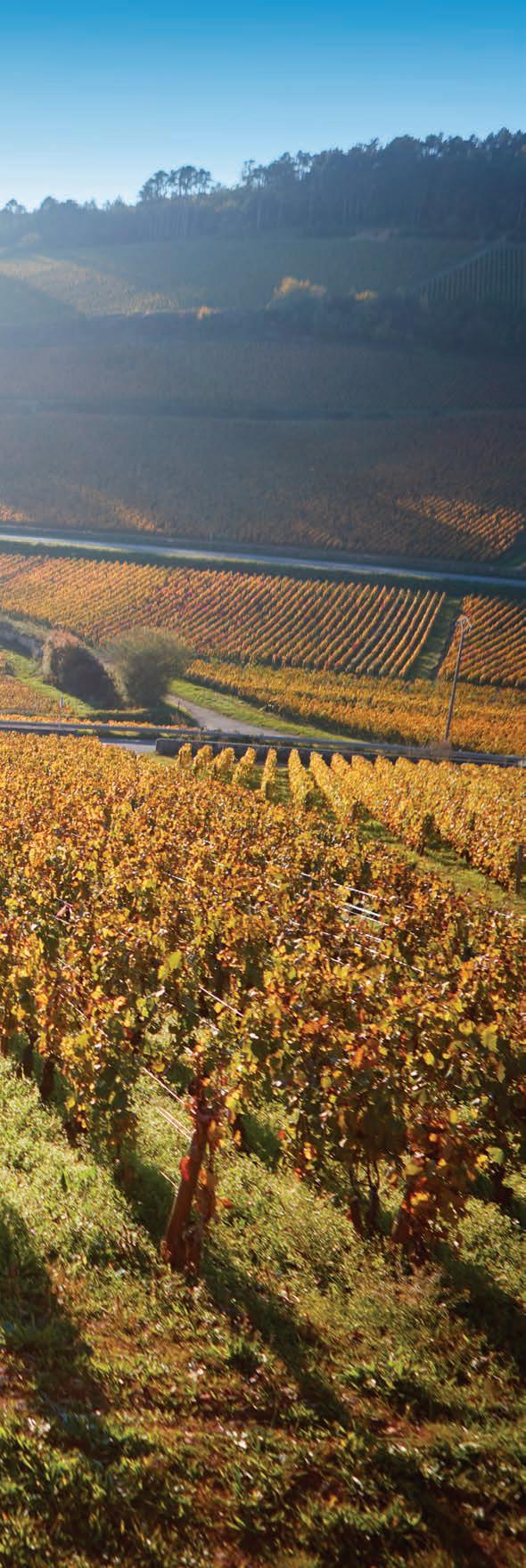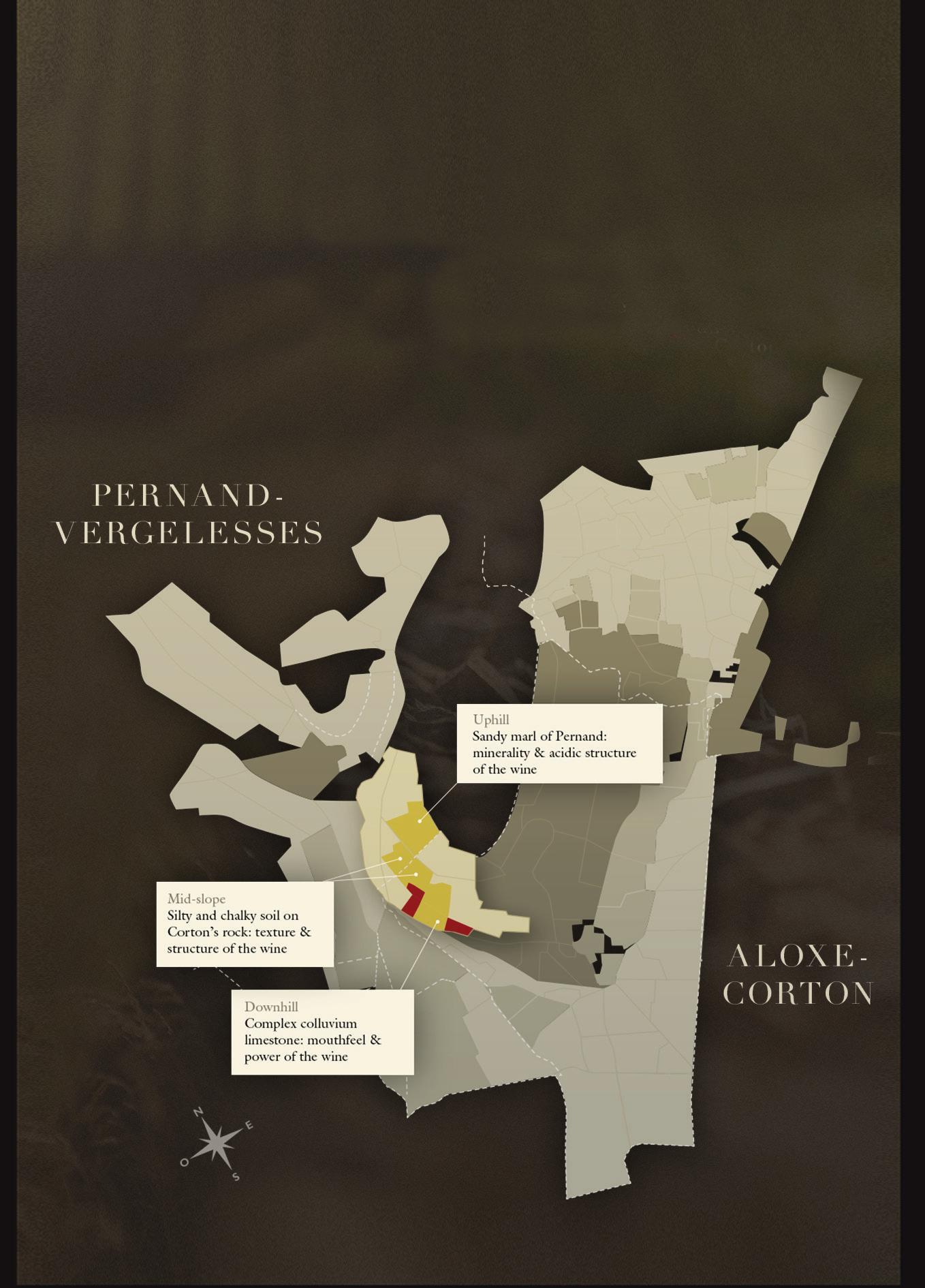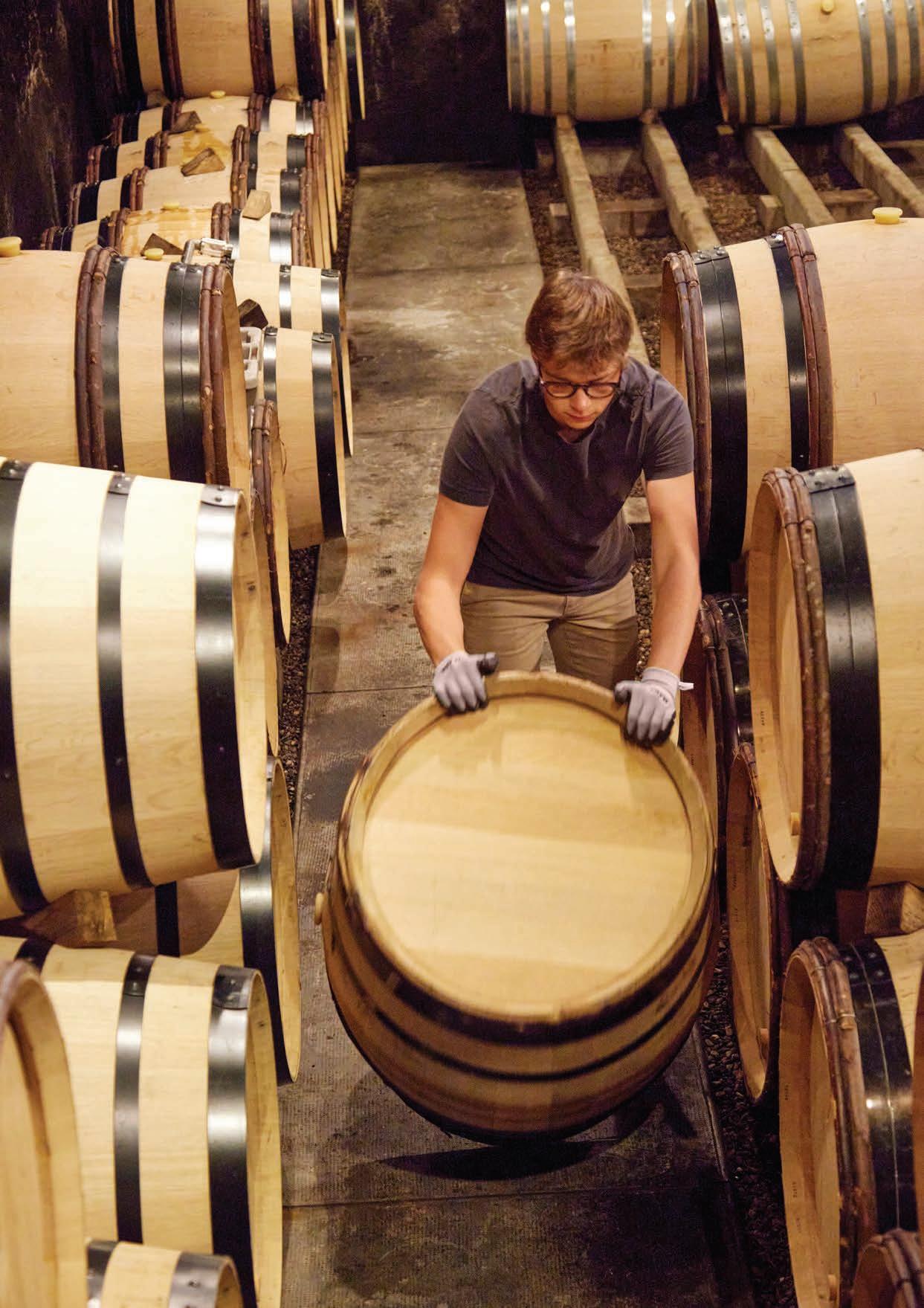DOMAINE BONNEAU DU MARTRAY
2021 VINTAGE, EN PRIMEUR
EXCLUSIVE TO CORNEY & BARROW IN THE UK

“A true Charlemagne: rich and powerful yet austere, with an underlying stony backbone.”
THIBAULT JACQUET, DOMAINE BONNEAU

MARTRAY, APRIL 2024DU


EXCLUSIVE TO CORNEY & BARROW IN THE UK

“A true Charlemagne: rich and powerful yet austere, with an underlying stony backbone.”
THIBAULT JACQUET, DOMAINE BONNEAU

MARTRAY, APRIL 2024DU

This year, Bonneau du Martray’s CortonCharlemagne has become simply Charlemagne.
As manager Thibault Jacquet puts it, this name change is a tribute to the Emperor Charlemagne who, in the year 775, gave these vines on the hill of Corton to the Benedictine monks of nearby Saulieu.
Thibault also refers to a “rediscovery” of Charlemagne Grand Cru. This historic climat comprises the hill’s two great white wine lieuxdits, ‘En Charlemagne’ and ‘Le Charlemagne’, across which the domaine’s holdings stretch.
A coming-together, therefore, which serves to further distinguish the domaine’s white from its red. We now have Charlemagne Grand Cru and Corton Grand Cru.
Since the 2020 vintage, which we offered last year, the domaine’s wines have been released once bottled. This later release model has been adopted by several top Burgundy estates over recent years and enables uninterrupted ageing and more informed quality assessment. Waiting a year longer to get our hands on the wines is a small price to pay.
This also brings the release timing in line with that of Domaine de la Romanée-Conti, to whom Bonneau du Martray leased just under a third of its Chardonnay vines, from the 2019 vintage.*
The 2017 acquisition by US businessman E. Stanley Kroenke was only the fourth time the domaine has changed hands in its 1,200+ year history. The management team of Armand de Maigret and Thibault Jacquet also look after Mr Kroenke’s Californian estates, which include Screaming Eagle. 2021 is their fifth vintage at Bonneau du Martray. Vineyard manager Fabien Esthor has been at the domaine since 2003 and cellar manager Emmanuel Hautus since 2011.
We tasted the 2021s with Thibault in May. Sadly, our tiny allocation will evaporate upon release: Charlemagne’s yield was a paltry 7hl/ha, against an average of 40hl/ha. However, those lucky enough to get a few bottles will have something to cherish. A low point in terms of volume (we hope), but an important step forwards for a domaine whose future promises to be as illustrious as its past.
GUY SEDDON HEAD OF FINE WINE BUYINGJUNE
2024*2.8 hectares of its total 9.5 hectares


With a dozen centuries behind it, this is an estate which can trace its origins directly to the Emperor Charlemagne in 775.
This was the year in which, in compensation for the destruction of their abbey by the Saracens, the Emperor gifted these vines on the hill of Corton to the monks of Saulieu.
The Church owned the estate for just over a thousand years until the French Revolution, following which it was acquired by René Bonneau du Martray’s family, descendants of Nicolas Rolin, who founded the Hospices de Beaune in 1443.
In the 19th Century, the Bonneau du Martray family controlled almost 24 hectares of vines, including the whole of the Charlemagne climat
René Bonneau du Martray, born in 1886, left the estate to his niece, Comtesse Alice le Bault de la Morinière, whose husband Jean took over in 1969. Jean began the estate’s renaissance, enlarging and improving the cuverie and cellars and introducing estate bottling and temperature control.
Jean’s son, Jean-Charles le Bault de la Morinière, joined the domaine in 1994. Highly respected for his wines and his research into the intricacies of the hill of Corton, Jean-Charles began the process of conversion to biodynamics, which is now a fundamental part of the domaine’s approach.
In 2017, US businessman E. Stanley Kroenke became only the fifth owner in the domaine’s history, bringing Bonneau du Martray into the same vinous family as California’s Screaming Eagle, The Hilt and Jonata.
At the heart of the Charlemagne climat, the holdings span En Charlemagne on the hill’s northern Pernand-Vergelesses side and Le Charlemagne on the southern Aloxe-Corton side.
Following the lease of 2.8 hectares of Chardonnay vines to Domaine de la Romanée-Conti, the area of Chardonnay in domaine production is now 6.7 hectares. Added to the 1.6 hectares of Pinot Noir (Corton Grand Cru), the holdings are now 8.3 hectares. However, one of the three plots of Pinot Noir was grubbed up in 2018 and was replanted in spring 2022, meaning the Corton Grand Cru 2021 comes from less than a hectare.
The only west-facing grand cru in the Côte d’Or, Charlemagne’s vines get full exposure to the afternoon sun. This unique aspect is accentuated by the heat-reflective white marl soil. The freedraining higher plots are protected from the wind by the hilltop wood, whilst cold humid air passes through the valley at the foot of the slope.
The hill of Corton, with its voluptuous curves and generous woodland at its crest, some 300 metres above sea level, has a bedrock of limestone, overlain by Jurassic soil. The upper slopes are mostly white marl, with the proportion of iron and clay increasing as you descend.
Describing how different points on the slope influence the wines’ characters, Thibault Jacquet singled out three of the 15 plots, which he
describes as “microclimate typicities”. An upper section called Rollin Haut has poor soils, bringing mineral tension and acidity to the final blend. These upper slopes are the richest in active calcium, making for wines of bite and mineral texture. A mid-slope parcel, Grande Plante, confers a more generous, full-fruited character, whilst Les Latours, on the lower slopes, has deeper, iron-rich soils which contribute density and body.
The earlier ripening lower plots tend to be picked first, the upper ones last. The 40-strong harvest team typically takes a week to bring in the domaine’s grapes. Each plot is vinified separately. Even mid-replanting programme, the average vine age is over 50 years. Yields are low, 40 hectolitres per hectare (hl/ha) for the white and under 30 hl/ha for the red on average.
No herbicides or fertilisers are used and yields are kept in check by severe pruning in the early growing season. There is no green harvest, the domaine prioritising rigorous debudding (envasivage) and removal of the lateral shoots (entrecoeurs) in early spring. Biodynamic trials started in 2004, with certification for the Pinot Noir in 2012 and the Chardonnay in 2014.
Grape Variety Chardonnay
Vineyard Holding 2020
6.7 hectares
Average Age of Vines 59 Years
Average Yield 40 hl/ha

Grape
Vineyard Holding 2020 1.59 hectares
Average Age of Vines 57 Years
Average Yield 30 hl/ha
Chardonnay grapes are picked plot by plot, then brought in from the vineyards in small, slatted crates to prevent them from breaking. Upon arrival in the vat room, they are crushed and pressed to extract their phenolic substance, as well as enabling a gentler pressing. Emmanuel Hautus retains more solids than previously, to build depth and texture.
After settling, fermentation takes place, in oak of various formats, including barrels and foudres, as well as ceramic vessels. The average new oak in 2021 is 25%. Addition of sulphites is delayed for as long as possible after completion of malolactic fermentation, to encourage a natural stability in the wines.
The wine then spends 12 months on its lees, without stirring. Each of the 11 blocks of Charlemagne is kept separate for fermentation and the first 12 months of élevage. The aim, as described by Thibault Jacquet, is harmony between the three microclimates of Charlemagne.
The wine is then blended and spends a further nine months (a second winter) in reductive vessels – principally stainless steel tanks. The first blend is between plots of the same microclimate. At the end of this period, a second racking separates the wine from its lees.
The wine then rests for a month before bottling in accordance with the lunar calendar. A waning moon with a “small tidal coefficient” is ideal.
3-5% of the Pinot Noir crop is fermented in terracotta amphorae, as whole berries, with no crushing. The rest is destemmed and then sorted. Starting in the 2019 vintage, the two red wine parcels have been fermented separately and matured in barrels (50% new oak) for 12 months before being blended in vats to finish the ageing process over a further nine months.
When it comes to bottling, the domaine always uses high quality natural cork, for both the white and the red. Four cork suppliers are used, to mitigate any possible risk. Corks from each batch are checked by soaking them in water and then tasting.



“2021 taught us to never give up, to be patient and obstinate. 2021 was tough, but what a beauty.”
After a mild (too mild) winter, the first signs of spring appeared early and the vegetation started to grow just as quickly – unfortunately too quickly.
April’s frost left us with almost nothing. Three nights of ice and two days of snow, with temperatures reaching -7°C, was enough to wipe out nearly the entire crop. Implacable nature and powerless mankind.
We were hoping that the frosts would not be the whole story and that better conditions would help revive our ecosystem… but they just never came. A rainy spring followed by a wet yet warm summer with an invisible sun made for conditions favouring development of both mildew and oidium. More worries…
The maturity of our grapes was finally reached by mid-September. The tiny harvest (a bunch per vine on average, sometimes more, sometimes none) was first sorted in the vineyards.
Upon arrival in the winery, the grapes were pressed in the ‘Champagne way’. The last juices were discarded to keep only the heart of the press wine: the purest and most aromatic juice. Then the juice was settled in tank, from which a further selection was made of the finest juice and lees. Some blocks were immediately blended in barrels.
In 2021, the challenge was to stretch this core of power as much as possible, while preserving the vintage’s soul and the wine’s energy.
No sulphur was added during ageing, to let the wine develop fully in oak, concrete, sandstone or stainless steel. We also extended the ageing in the cellar to two years for that purpose. Only before bottling was a drop of sulphur added, to stabilise the wine and make sure that no dissolved oxygen remained.
2021 is a vintage that demanded a lot of us for three years, but today when we taste it at home with the team, it is one of great emotion that makes everyone smile.
Re-christened Charlemagne for the 2021 vintage, the wine that was previously known as Corton-Charlemagne comes from 6.7 hectares, spread across the hill’s two great white wine lieux-dits of En Charlemagne (PernandVergelesses side) and Le Charlemagne (Aloxe-Corton side). Such an intense, pure nose of powerful white peach, with orange blossom and a line of flinty reduction. The palate opens pure and strident – citrus and pear fruit with incisive stony minerality – coming to a bitter pithy focus on the long finish, on which lemon rind and white flower perfume linger. Bottled in late August 2023. 25% new oak. The yield was just 7hl/ha. 13% abv. Just over 3,000 bottles were produced.
Corney & Barrow Score 18
Recommended drinking from 2027 - 2039
£2,970/Case of 6 bottles, in bond UK
A very pale ruby colour, redolent of the domaine’s Cortons of the previous era. Beautiful rose and exotic spice aromas. The palate opens lean and mineral, revealing a mediumbodied mid-palate whose reticent red berry fruit hangs on a rod of taut acidity. Perfume fills the finish rather wonderfully. This bears a distinct resemblance to Bonneau du Martray’s Corton of old, with the polished prettiness of the current regime. One of the three Pinot Noir plots was grubbed up in 2018 and replanted in spring 2022, meaning the Corton 2021 comes from less than a hectare. Bottled late August 2023. 50% new oak. 13% abv.
Corney & Barrow Score 17.5
Recommended drinking from 2027 - 2040
£1,485/Case of 3 bottles, in bond UK
Our tasting notes provide full details but, at your request, we have also introduced a clear and simple marking system. We hope these guidelines assist you in your selection. For the benefit of simplicity, wines are scored out of 20. We will often use a range of scores (e.g. 16.5 to 17) to indicate the potential to achieve a higher mark. When a ‘+’ is shown it adds further to that potential. Wines from lesser vintages will, inevitably, show a lower overall score.
Wines are judged, in a very broad sense, against their peers. Why? Well, you cannot easily compare a Ford with an Aston Martin, other than they are both cars and have wheels. It is not that different with wine. A score is a summary only. The devil is in the detail, so please focus on the tasting notes and, as always, speak to our sales team.
PLEASE NOTE
These wines are released en primeur. Delivery dates to be confirmed. All prices are quoted in bond UK.


Our revised drinking dates are merely a reminder of what we recommended upon original release. We do not say that you cannot drink wines older if you wish, merely that we cannot continue to guarantee them if you ignore our recommendations!
LONDON
1 Thomas More Street London E1W 1YZ
T +44 (0)20 7265 2400 sales@corneyandbarrow.com
LEEDS
4 Park Square East Leeds LS1 2NE
T +44 (0)1133 400 380 northofengland@corneyandbarrow.com
EDINBURGH
Oxenfoord Castle by Pathhead Midlothian, Scotland EH37 5UB
T +44 (0)1875 321 921 edinburgh@corneyandbarrow.com
NEWMARKET
Belvoir House, High Street Newmarket, Suffolk CB8 8DH
T +44 (0)1638 600 000 newmarket@corneyandbarrow.com
AYR
8 Academy Street, Ayr Ayrshire, Scotland KA7 1HT
T +44 (0)1292 267 000 ayr@corneyandbarrow.com